牛津高中英语 牛津版 译林版 高一 模块二 Unit1 Tales of the unexplained 教案
高一牛津译林英语必修二教学课件:Unit 1 Tales of the unexplained welcome(共34张PPT)

Justin’s sister said she heard him heard him
return and he went 5._s_t_r_a_i_g_h_t_to his room and 6._p_u__t_ on a CD. Then she saw a bright
Post Reading
Task 1: Fill in the blanks with proper words
Justin Foster, a 15-year-old boy, went
1._m__is_s_i_n_g__in Dever, New Hampshire. Police in America have 2._s_te_p__p_e_d__up their search
2. In the second paragraph, “show up” means_______.
A. arrive or appear B. reach C.
disappear
D. reach for
3. From the third paragraph, we know that________.
4. According to Paragraph 5, we know that __________.
A. the light that Kelly saw was the light of the full moon
B. the spaceship was white all over
C. Kelly saw the aliens take Justin away
牛津译林高一英语模块二Unit 1 Tales of the unexplained教学课件:Reading
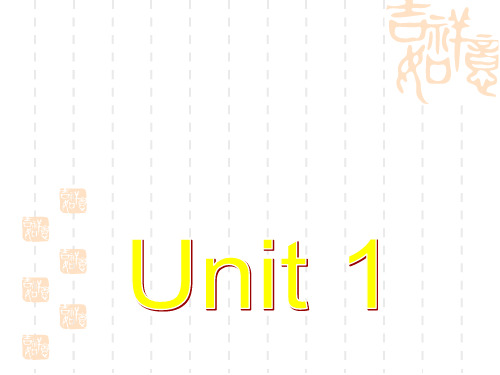
+
a UFO
+
What happened last Friday
=?
返回目录
Read the following newspaper article quickly and answer these questions.
1. What is the article about? 2. WhTehnewaartsicJleusistinablaosutt saemenis?sing boy. 3. Who is in charge of the case?
Boy missing, police puzzled
Warming up Fast reading Detailed reading Discussion Homework
1. Do you believe in the existence of aliens?
2. Look at the title and pictures, what information can you get from them?
How to read a newspaper
artittliecle?
( to give a general idea about the news )
the first paragraph
( to tell readers “who” “when” “where” “what” “why” “how” )
Friday night.
Detective Sam Peterson.
( T) 1. Justin Foster lives in Dover, New Hampshire. ( ) 2. Justin plays football. ( ) 3. The witnesses saw Justin walking home at 11:00 p.m.
牛津译林高一英语模块二Unit 1 Tales of the unexplained教学课件:Task

1. Greeting someone formally, we can use: Good morning / afternoon. Nice to meet you.
2. Greeting a friend or classmate, we use: Hello! / Hi!
3. Greeting a stranger, we can use: Good morning / afternoon/evening. Excuse me, sir / madam. Hello.
What will you do after greeting a stranger?
We can introduce ourselves and tell the person what we want to do and why.
Excuse me, sir. I am Sanha. I’d like to ask you a few questions if you don’t mind.
• Question 4 should be made more specific by adding the words ‘in the last six months’.
• The explanation in brackets for Question 6 should be simplified as the following: (Please write down your answer.)
5. Do you know how to conduct an interview?
6. Do you think it is important to interview persons in appropriate ways?
高一牛津译林版英语必修二课件精选:Unit 1 Tales of the unexplained word power(共13张PPT)

Now there is a scientist who will tell you something about outer space and space exploration. Here are some pictures. Can you name them?
launch pad
space shuttle tracking ship
I guess some of you are dreaming of becoming an (1)astronaut and traveling to (2) space carry out (3) space exploration. If this comes true, you will probably travel by (4)space shuttle, a spaceship that looks like an aeroplane. Two (5)rockets supported by a launch towerwill lift the space shuttle into space. Some time after the rockets and the space shuttle are (6)launched, the rockets will separate from the space shuttle and fall into the sea. Then a ship will pick them up. Astronauts will do their research in a base in outer space called (7)space station. Sometimes they go out of their space shuttle to take a (8)spacewalk. In outer space astronauts cannot take off their (9)spacesuits, which protect them and provide oxygen. In 1965, Alexei leonov from the former Soviet Union became the first human being to take a walk in space,.
译林牛津版高一英语模块二 Unit 1 Tales of the unexplained 知识点讲解
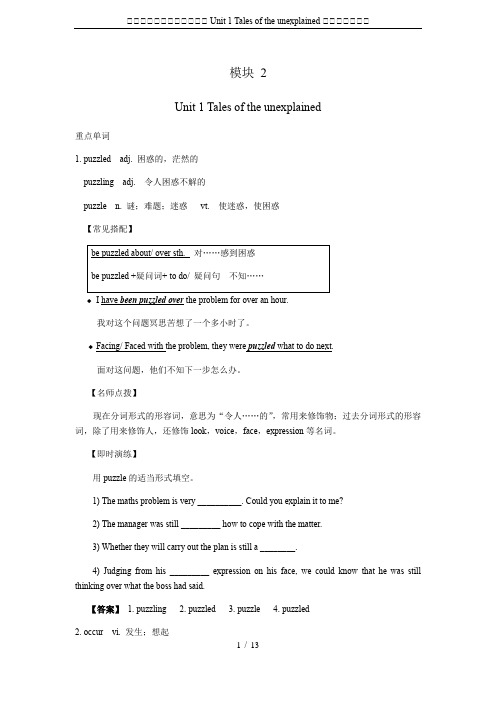
模块2Unit 1 Tales of the unexplained重点单词1. puzzled adj. 困惑的,茫然的puzzling adj. 令人困惑不解的puzzle n. 谜;难题;迷惑vt. 使迷惑,使困惑【常见搭配】◆I have been puzzled over the problem for over an hour.我对这个问题冥思苦想了一个多小时了。
◆Facing/ Faced with the problem, they were puzzled what to do next.面对这问题,他们不知下一步怎么办。
【名师点拨】现在分词形式的形容词,意思为“令人……的”,常用来修饰物;过去分词形式的形容词,除了用来修饰人,还修饰look,voice,face,expression等名词。
【即时演练】用puzzle的适当形式填空。
1) The maths problem is very __________. Could you explain it to me?2) The manager was still _________ how to cope with the matter.3) Whether they will carry out the plan is still a ________.4) Judging from his _________ expression on his face, we could know that he was still thinking over what the boss had said.【答案】1. puzzling 2. puzzled 3. puzzle 4. puzzled2. occur vi. 发生;想起【常见搭配】【相关拓展】【即时演练】A: 完成句子1. A good idea suddenly occurred to him. 他突然想到一个好主意。
译林牛津版高中英语模块二短语、词汇语法归纳汇总

译林牛津版高中英语模块二短语、词汇语法归纳汇总Unit 1 Tales of the Unexplained一、Reading1. run into sth: 偶然遇见;撞到;遭遇①The car ran into a tree all of a sudden.②I have run into debt for a long time.2. step up sth: 增加;加快;加强Step up production.3. go missing: 失踪When loved ones go missing, hope is "the only thing you have left".亲人失踪时,希望是你留下的唯一的东西。
4. due: adj. 因为;预期的;到期的;适当的due to sth: 因为……be due to do sth: 预定∕预期……fall / become / be due: 到期in due course: 在适当时期①The team’s success is largely due to his efforts.②His book is due to be published in October.③My house rent isn’t due until Wednesday.④Your request will be dealt with in due course.5. search: vt. & n.搜寻,搜查search for sth: (=look for sth) 寻找……search sth for sth: 搜查……以寻找……search sth out: 查出∕找出……in search of sth: 寻找……①search the woods for escaped prisoners.②We have searched out several your favorite recipes.③Scientists are in search of a cure for the disease.6. witness: (1) n. 目击者;证人be witness to sth: 目击∕证实……We were witness to the accident.(2) vt.目击,见证This year has witnessed the rapid development of China’s economy.7. put on sth: (1) 穿上:put on your coat (2) 播放:put on a record(3) 上演,举行:put on a concert (4) 增加:put on weight8. Standing inside lots of strange creatures wit white……(Page 2, Lines 36-38)表示方位的副词、名词短语、形容词短语、介词短语放在句首,而且主语是名词时,句子完全倒装。
牛津译林版高中英语必修二高一英语unit1《Talesoftheunexplained-Wordpower》课件

artificial satellite
Word power
Go through Part C and fill in the blanks using words from page 6.
I guess some of you are dreaming of becoming an________ astronaut and traveling to ______ _________________. space to carry out space exploration If this comes true, you’ll probably travel by space ____________, shuttle rockets a spaceship that looks like an aeroplane. Two ______ supported by a launch tower will lift the space shuttle into space. Some time after the rockets and the space shuttle launched the rockets will separate from the space are ________, shuttle and fall into the sea. Then a ship will pick them up. Astronauts will do their research in a base in outer space space station Sometimes they go out of their space called ___________. spacewalk In outer space astronauts shuttle to take a _________. spacesuits which protect them and cannot take off their _________, provide oxygen. In 1965, Alexei Leonov from the former Soviet Union became the first human being to take a walk in space.
译林牛津高一模块2unit1talesoftheunexplained全单元
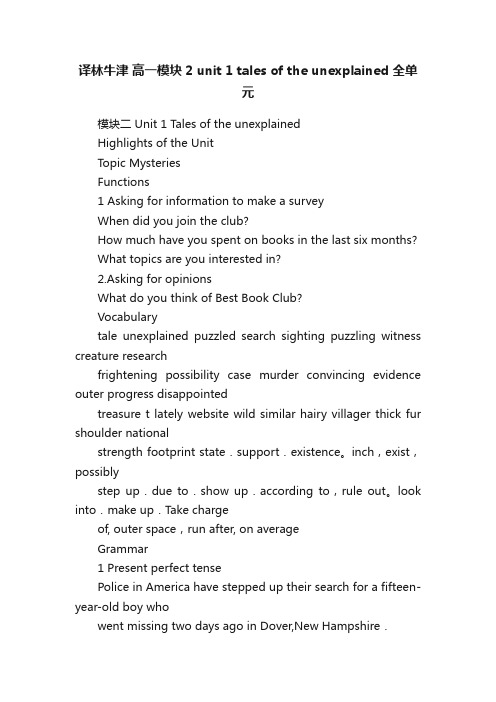
译林牛津高一模块2 unit 1 tales of the unexplained 全单元模块二 Unit 1 Tales of the unexplainedHighlights of the UnitTopic MysteriesFunctions1 Asking for information to make a surveyWhen did you join the club?How much have you spent on books in the last six months?What topics are you interested in?2.Asking for opinionsWhat do you think of Best Book Club?Vocabularytale unexplained puzzled search sighting puzzling witness creature researchfrightening possibility case murder convincing evidence outer progress disappointedtreasure t lately website wild similar hairy villager thick fur shoulder nationalstrength footprint state.support.existence。
inch,exist,possiblystep up.due to.show up.according to,rule out。
look into.make up.Take chargeof, outer space,run after, on averageGrammar1 Present perfect tensePolice in America have stepped up their search for a fifteen-year-old boy whowent missing two days ago in Dover,New Hampshire.2 Present perfect continuous tenseI haven’t been sleeping well since I returned home.Skills andStrategiesBy the end of this unit,students will be able to:1 read a newspaper article2 identify specific information through listening3 introduce themselves and conduct an interview4 draw conclusions and make recommendations after analysing statistics5 write a report6 expand vocabulary related to space explorationCulture 1 The Loch Ness Monster, Stonehenge,the Great Pyramid2 Yetis in different places in the worldPeriod 1 Welcome to the unitTeaching aims:Talk about some mysterious or unexplained phenomena, including evidence of UFOs, the possible existence of Yetis and the Loch Ness Monster, reasons for building Stonehenge and the pyramids.Make full use of resources and share their imaginative ideas with each other by participating in all the activities.Teaching proceduresStep 1 Brainstorming1 Assign students the following task: surf the net or refer to some reference books (in English or in Chinese) to get some information about UFOs, Yetis, the Loch Ness Monster, Stonehenge and the pyramids in Egypt.2 Ask students to read the instructions and focus on the fivepictures and illustrations first. Arouse their interest by asking them the following questions:Do the five pictures have something in common? If so, what is it?(unexplained; no satisfactory answers; mysterious; no evidence ...)Can scientists explain these phenomena?How do you feel about them? Are you a bit curious?3. Ask students to think of as many expressions as possible to answer the questions above. Encourage them to make up sentences and read them to the class. Share the following sentences with students as examples.4. Report the information they have collected to the class. Students' answers might differ. Vary the activities according to students' responses. Some answers students provide can be used as a prompt for a class discussion. For example,Teacher: What information have you got about UFOs?Student A: ...Teacher: Do you think Student A' s information is interesting?What about the information you've got? Is there something different?Student B: ...This activity is flexible.Ask students to discuss the topics in pairs. Here are some questions.About UFOs:Have you ever read some reports about UFOs in China?Are you interested in UFOs?Are they really from another planet?What do the letters UFO stand for?Why do you think UFOs visit our planet?About Yetis:Where are the Himalayas?What's the weather like there?Why do some people make great efforts to climb them?(hobby; dream; challenge themselves; make discoveries; overcome difficulty,..)A Yeti is reported to be half-man and half-beast. Have you heard of it?Do you think some climbers' disappearances are connected with Yetis?About Stonehenge, the pyramids and the Loch Ness Monster: Stonehenge and the pyramids in Egypt, the most famous of which is the Great Pyramid, are cultural relics.Where were the pyramids built, on the east coast of the Nile or on the west coast ?What are the reasons?Do you think the Great Pyramid is a wonder in human history?How was the Great Pyramid built?I haven't heard of Stonehenge or the Loch Ness Monster. They are a bit new to me. What about you?Would you be interested in discovering more about them?Step 2: Sharing information1. Let's dealing with the questions in pairs. For the first question, you may discuss it this way: Do you believe in UFOs? What might be the most acceptable explanation for UFOs?Summarize the answers, and then report to the class.HomeworkRead and recite the new words.Workbook Ex. P.92 ABCPeriod 2 Reading (1)Teaching aimsLearn the text and catch the main idea.Do some Ex. to train S’ reading ability.Teaching aidsTape-recorder, computer,Teaching proceduresStep 1 Lead-in1. Some questions about UFODo you know what the three letters UFO stand for?Have you ever heard of the UFOs?Have you ever had the chance to see one?Do you believe the usual sayings about the UFOs?What do you think a UFO is?Do you think there are any creatures on it?Where do you think the creatures come from?Will they become our friends or enemies?2. Now, look at the pictures on pages 2 and3. Look at them carefully. And get ready to answer these questions:Picture 1: Is the first picture one of a UFO?Are there really UFOs from the outer space?Picture 2: Who was the missing boy?Does he like playing football or baseball?Picture 3: What's the picture about?Does the bright light outside the window come from a UFO?Does the bright light have something to do with Justin's missing?(Use the projector or macromedia to show the situations in the three pictures and ask the students the same questions as given above. Check answers inpairs. Check the answers with the whole class.)3. Answer the following questions, focusing on the title of the article, Boy missing, police puzzled.Does the title arouse your interest when you read it?Can you complete the title?What information can you get from the title?What else do you want to know? For example, 'boy missing' (How/When/Where was the boy missing?) 'police puzzled' (Why are they puzzled?/What are the police going to do about the boy's disappearance and how?)Are you curious about why the writer uses an incomplete sentence as the title?Did you know that it is a feature of a news title?What are some other features of a news title?Can you guess what details may be covered in the following news story?Step 2: Fast reading for general ideas1. Before skimming the passage, please look at the news photographs first and describe what is happening in them. Then find the answers to the three questions above the text:1) What is the article about? (The article is about a missing boy/UFOs and aliens.)2) Who is missing? (Justin Foster is missing.)3) Do the police know what happened to Justin? (No.)2. Read the first paragraph carefully to get the main idea and the important facts such as:When and where was the boy missing? What caused the boy's sudden disappearance? How old was the boy? Why did people show interest in his disappearance?3. Listening and T/F exercises1.Police in America have stepped up their search for a thirteen-year-old boy.2. Justin foster, a high school student, went missing last Saturday.3. Justin’s sister, Kelly, says she saw her brother return home at about 11 p.m.4. Kelly pulled back the curtains and saw a spaceship flying outside.5. The police were sure that Justin was taken by aliens.Keys F F F T F4.Now scan the article again and locate specific information according to Parts CI and C2. P.4C 1 1.Where does Justin Foster live? He lives in Dover, New Hampshire.2.Why did Justin’s mother go to bed early?She went to bed early because of a headache.3. What time did the witnesses see Justin? At 10.45 p.m.4. What color were the aliens? They were white5. Who else has been taken by the aliens? Mavis Wood has been taken by the aliens.6. Who was in charge of the case?Detective Sam Peterson was in charge of the case.C2 Main points Supporting detailsJustin foster went missing Mrs Foster thought he was spending the night with a friend.Mr Foster was surprisedThe police found thatJustin returned home. Justin’s friends saidWitnesses saidKelly heardThe boy was taken away by aliens. Kelly sawKelly heardMavis Wood saidStep 3: Detailed reading for important informationDo Ex. E on P.5Keys bad, favourate alients creatues nightmare Justin not puzzled witnesses murdered2. Having read the text, please pay attention to the different features of each paragraph.1) First let's have a discussion about how we usually decide whether a news article is worth reading or not and what methods we use in our reading. As we all know, newspapers play an important part in our daily life. Wherever you are, you can be informed of the latest news by reading a newspaper. From your experience, how do you usually select the news you'd like to read, by taking a look at its title or being attracted by its colorful pictures?Every one of you can express your own opinions and give the reasons.2) Compared with the other paragraphs, is the first paragraph the most important one in the article? Please describe the differences between the first paragraph of the article and the paragraphs that follow.3) Ask Ss to read the Reading strategy 'reading a newspaper article'. Pay attention that both the title and the first paragraph, which is called the lead paragraph, play a key role in understanding of news articles.Step 4 InterviewingSuppose you are a reporter from China Daily. You are making a face-to-face interview with Justin Foster who has just comeback home.HomeworkRead the text and try to retell it .Finish Ex.Period 3 Reading (2) Language PointsTeaching aims1.Learn some useful words and phrases.2.Practise using them.Teaching aids:computer, multi-media TeachingTeaching Procedures:Step 1 RevisionCheck the homework exercises.Step 2 Listen to the tape and read the text after it.Step 3 Language PointsAsk Ss to watch the Powerpoints and learn the useful Phrases.<详见学案语言点>Step 4 PractiseDo some exercises.Step 5 HomeworkRead the text again and try to retell it.Finish the exercises.Period 4 Word PowerTeaching aimsLearn some new words and enlarge Ss’ vocabulary.Teaching proceduresStep 1 Brainstorming Think about the following questions:1).Whether UFOs really exist has puzzled US for a long time.Have you ever thought about exploring space one day?2).Are you interested in making discoveries in space?3).What achievements have humans made so far in space exploration?4).Who was the first man to travel in space?5).When did the first man land on the moon? And how?6).What do you know about him?While focusing on the questions above,please pay attention to some other new words related to space,such as astronaut,spaceship/space shuttle ,orbit,etc. give SS more information about the history of space exploration and the history of the space shuttle.Step 2:Vocabulary learningRead the first part of the speech and complete the time line of the main events mentioned.Time Event Sign1957 the launch of the 1st artificial satellite1959 unmanned spaceships launched into space Space exploration began.1961 1 st human being traveled in space People orbited the Earth。
(牛津译林)高一英语必修二教学课件:Unit1TalesoftheunexplainedProject(共21张PPT)
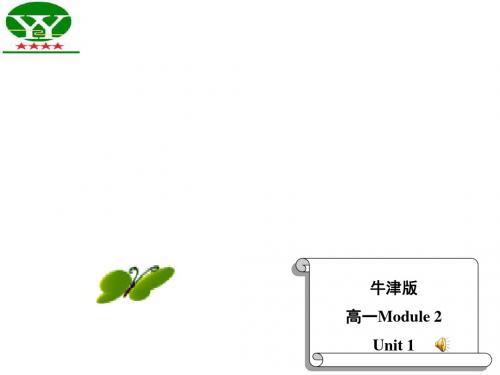
Part four: to give readers imagination with an open ending
Conclude the writing features
1. an interesting and attractive title
You all did a good job! Thank you! Good bye!
1970
in the Shennongjia National Forest Park near Bossburg, Washington in the USA
ten Chinese engineers
saw a Yeti
footprints of the Yeti were discovered
Analyze the writing features of the article.
UF√O ?
_E_g__y_p__t is famous for pyramids?
Reason for building them?
√ A: known B : unknown
Stonehenge
Who and why built it ?
A: known √B:unknown
Group work:
2. an attractive beginning 3. details of the story with pictures 4. scientists’ or people’s different
opinions 5. an open end of the story
牛津高中英语_牛津版_译林版_高一_模块二_Unit1_Tales_of_the_unexplained_教案

Unit 1 Tales of the unexplainedPart 1: Teaching DesignProcedures●Welcome to the UnitStep 1: Brainstorming1. Boys and girls, have you ever heard something not only interesting and attractive but also unexplained at alleven with the help of modern science and technology in the world? Here are some pictures on the screen. Can you tell me what they are?The chances for seeing a UFO are greater for those people who live in small towns or in the country and are outside late at night.UFOs. Yes, they are called UFOs, meaning unidentified flying objects.UFOs come in all shapes and sizes. Some are only small spots of light that move in strange patterns across the night sky.Some can be seen in the daytime are often disk- or saucer-shaped.UFOs were once seen in different parts of China. Look at some pictures on the screen, please.Do you think such kind of things mysterious ? Are you curious about them? Besides UFOs, can you list anything more unexplained you’ve ever heard or seen in your daily li fe?They are Yetis, the Loch Ness Monster, Stonehenge and the Pyramids in Egypt.2. Open your books and let’s look at page one. Please read the instruction and focus on the five pictures andillustrations first. Then answer the following questions:Do the five pictures have something in common?If so, what is it? (unexplained; no satisfactory answers; mysterious; no evidence...)Can scientists explain these phenomena?How do you feel about them?Are you a bit curious?3. Think of as many expressions as possible to answer the questions above. Try to make up some sentences andread them to the class. I will also offer you some examples.They are mysterious because no satisfactory answers have been offered to explain them. Though thesemysteries have puzzled people for a long time, they still show great interest in them.People feel puzzled by the mysteries.4. Report the information you have collected to the class. Your answers are quite different. Now we will usesome of your answers as a prompt for a class discussion. For example,Teacher:What information have you got about UFOs?Student A:...Teacher:Do you think Student A's information interesting? What about the information you've got? Is there anything different?Student B:...5. Please discuss the topics in pairs. Here are some questions.About UFOs:Have you ever read some reports about UFOs in China?Are you interested in UFOs?Are they really from another planet?What do the letters UFO stand for?Why do you think UFOs visit our planet?About Yetis:Where are the Himalayas?What's the weather like there?Why do some people make great efforts to climb them?(hobby; dream; challenge themselves; make discoveries; overcome difficulty,..)A Yeti is reported to be half-man and half-beast. Have you heard of it?Do you think some climbers' disappearances are connected with Yetis?About Stonehenge, the pyramids and the Loch Ness Monster:Stonehenge and the pyramids in Egypt, the most famous of which is the Great Pyramid, are cultural relics. Where were the pyramids built, on the east coast of the Nile or on the west coast?What are the reasons?Do you think the Great Pyramid is a wonder in human history?How was the Great Pyramid built?I haven't heard of Stonehenge or the Loch Ness Monster. They are a bit new to me. What about you? Would you be interested in discovering more about them?Step 2: Sharing information1. Let’s deal with the questions in pairs. For the first question, you may discuss it this way: Do you believe in UFOs? What might be the most acceptable explanation for UFOs? You may give different answers such as: -Aliens from space.-Military test aircraft.-Some UFOs are alien, some are test aircraft.-UFOs are evidence of human space travel.-UFOs are neither alien nor test aircraft.-UFOs don't exist.You can express your agreements and disagreements with each other.2. Summarize your answers and then report to the class.Sample answersTeaching aims:1. Learn to read a passage of something about outer space exploration;2. Enlarge the vocabulary by learning about some words about outer space and space exploration. Teaching important points:1. Understand the meaning of the speech made by the scientist.2. Learn some new words about outer space and space exploration.Teaching methods:1. Competition to stimulate them to act quickly and actively.2. Associate to increase their interest and enlarge vocabulary.Teaching aids:1. the multi-media.2. the blackboard.Teaching procedures:Step 1Lead- inThink about the following questions:1.Whether UFOs really exist has puzzled US for a long time. Have you ever thought about exploring space one day?2. Are you interested in making discoveries in space?3. What achievements have humans made so far in space exploration?4. Who was the first man to travel in space?5. When did the first man land on the moon? And how?6. What do you know about him?While focusing on the questions above, please pay attention to some other new words related to space, such as astronaut, spaceship/space shuttle, orbit, etc. Give students more information about the history of space exploration and the history of the space shuttle.Step 2 Vocabulary learning1. Read the speech given by a scientist in Part A and tell the main ideas of the passage.In 1957 launch of the first artificial satelliteSince 1959 unmanned spaceships have been launchedBy 1961 orbit the earth, travel in spaceToday examine important planets, take photos, and collect samples2. Ask students to guess the words from some pictures.(launch pad, launch tower, launch shuttle, rocket, astronaut, spacesuit, spacewalk, space station, tracking ship)These words are new to students, so ask them to have a discussion by answering the following questions: (1) Space exploration began with the launch of the first artificial satellite. What does “launch’”mean? What word can be used to replace “artificial”? What about the word “man-made”?(2) How can a space shuttle be sent into space? Can it fly into space by itself?3. Read the second part of the scientist’s speech and complete Part C individually according to the instructions. We’ll then check the answers.Answers: 1 astronaut 2 space 3 space exploration 4 space shuttle 5 rockets6 launched7 space station8 spacewalk9 spacesuitsTo check students’reading comprehension by raising the following questions:1) What will happen to the rockets after the shuttle has been sent to space?2) Where will the astronauts do their research?3) Why can’t they remove their spacesuits?Step 3 Vocabulary extensionAsk students to focus on Part D and complete it individually.Answers: 1 Jupiter 2 Mercury 3 Mars 4 Neptune5 Pluto6 Venus7 Saturn8 UranusStep 4 Homework:1. Try to remember these new words about space and space exploration.2. Read more about space exploration after class.3. Preview Grammar.短语翻译1. 无法解释的传说,未解之谜tales of the unexplained2. 充满神秘full of mysteries3. 先进的科技advanced science and technology4. 偶遇run into/come across/meet by chance5. 相信未解之谜believe in unexplained things6. 某天(将来的) some day7. 做某事的理由reason for doing sth8. 提前in advance9. 加紧,促进step up10. 寻找某人。
牛津译林版高一英语必修二教学设计:Unit1 Tales of t
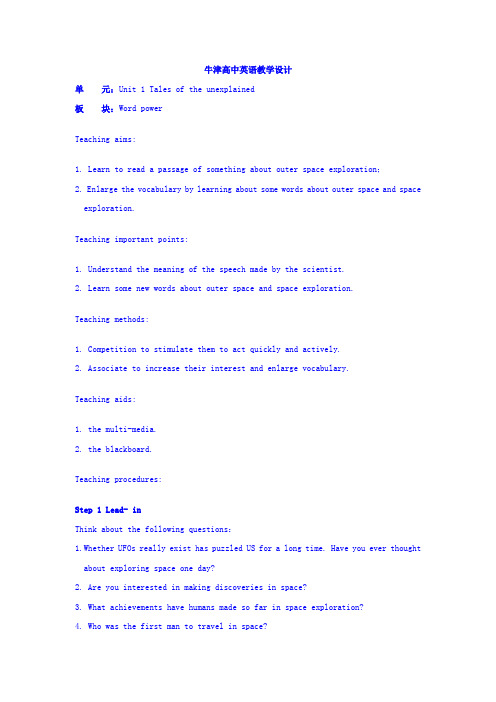
牛津高中英语教学设计单元:Unit 1 Tales of the unexplained板块:Word powerTeaching aims:1. Learn to read a passage of something about outer space exploration;2. Enlarge the vocabulary by learning about some words about outer space and space exploration.Teaching important points:1. Understand the meaning of the speech made by the scientist.2. Learn some new words about outer space and space exploration.Teaching methods:1. Competition to stimulate them to act quickly and actively.2. Associate to increase their interest and enlarge vocabulary.Teaching aids:1. the multi-media.2. the blackboard.Teaching procedures:Step 1Lead- inThink about the following questions:1.Whether UFOs really exist has puzzled US for a long time. Have you ever thought about exploring space one day?2. Are you interested in making discoveries in space?3. What achievements have humans made so far in space exploration?4. Who was the first man to travel in space?5. When did the first man land on the moon? And how?6. What do you know about him?While focusing on the questions above, please pay attention to some other new words related to space, such as astronaut, spaceship/space shuttle, orbit, etc. Give students more information about the history of space exploration and the history of the space shuttle.Step 2 Vocabulary learning1. Read the speech given by a scientist in Part A and tell the main ideas of the passage.In 1957 launch of the first artificial satelliteSince 1959 unmanned spaceships have been launchedBy 1961 orbit the earth, travel in spaceToday examine important planets, take photos, and collect samples2. Ask students to guess the words from some pictures.(launch pad, launch tower, launch shuttle, rocket, astronaut, spacesuit, spacewalk, space station, tracking ship)These words are new to students, so ask them to have a discussion by answering the following questions:(1) Space exploration began with the launch of the first artificial satellite. Whatdoes “launch’”mean? What word can be used to replace “artificial”? What about the word “man-made”?(2) How can a space shuttle be sent into space? Can it fly into space by itself?3. Read the second part of the scientist’s speech and complete Part C individually according to the instructions. We’ll then check the answers.Answers: 1 astronaut 2 space 3 space exploration 4 space shuttle 5 rockets6 launched7 space station8 spacewalk9 spacesuitsTo check students’ reading comprehension by raising the following questions:1) What will happen to the rockets after the shuttle has been sent to space?2) Where will the astronauts do their research?3) Why can’t they remove their spacesuits?Step 3 Vocabulary extensionAsk students to focus on Part D and complete it individually.Answers: 1 Jupiter 2 Mercury 3 Mars 4 Neptune5 Pluto6 Venus7 Saturn8 UranusStep 4 Homework:1. Try to remember these new words about space and space exploration.2. Read more about space exploration after class.3. Preview Grammar.。
译林牛津高一模块二第一单元语言点详析
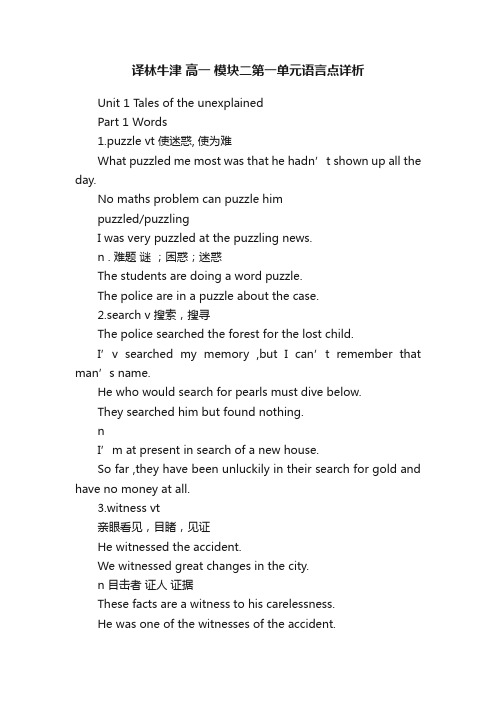
译林牛津高一模块二第一单元语言点详析Unit 1 Tales of the unexplainedPart 1 Words1.puzzle vt 使迷惑, 使为难What puzzled me most was that he hadn’t shown up all the day.No maths problem can puzzle himpuzzled/puzzlingI was very puzzled at the puzzling news.n . 难题谜;困惑;迷惑The students are doing a word puzzle.The police are in a puzzle about the case.2.search v 搜索,搜寻The police searched the forest for the lost child.I’v searched my memory ,but I can’t remember that man’s name.He who would search for pearls must dive below.They searched him but found nothing.nI’m at present in search of a new house.So far ,they have been unluckily in their search for gold and have no money at all.3.witness vt亲眼看见,目睹,见证He witnessed the accident.We witnessed great changes in the city.n 目击者证人证据These facts are a witness to his carelessness.He was one of the witnesses of the accident.4researchvNowadays the scientists are busy researching into/on our surroundings.The doctors researched into/on the cause of his death ,but no luck.ndo /make carry out research into /on sth5.case n 案子,案件;事情;箱子in this case 如果这样in that case 如果那样in case 以防万一in no case 决不in any case 无论如何6. charge1)n 负责责任After his father died ,he took charge of the firm ,and now he is in charge of the firm ;that’s to say ,the firm is in the charge of him.2) n /vt 收费,要价You can visit the exhibition free of charge.How much do you charge me for the use of telephone?3) 控告使担责任The court charged him with murder.7 murder vt /n 谋杀凶杀He was charged with an attempted murder.He was murdered on a cold evening.He murdered the whole work .n murderer 杀人者凶手8 convince vt使相信;信服;说服He convinced me that I should study law.He convinced me of his honesty.convinced /convincingPeople became convinced that they should prevent rivers from being polluted.You should give convincing evidence to make yourself convinced.9 disappoint vtWe shouldn’t do anything that will disappoint our parents.What disappointed me most was that I couldn’t go home .disappointed/disappointingHe was disappointed at the news that our team was defeated.The weather is disappointing.He is a disappointing man; nobody would like to stay with him.10. lately =recently多用于否定和疑问句]近来, 最近I haven't seen him lately.Have you been there lately ?注意:be late for school (adj)get up late (adv)11.mystery n 神秘Yesterday I read a story of mystery.Many problems that used to be mysteries to people are now solved.mysterious adj. 神秘的12.support vt 支撑,支持;搀扶;赡养She supports her husband on the money she earns from teaching.He has a large family to support.Don’t worry ! I support you .Which football team do you support?nDuring that election ,he won much support.13. exist viOne cannot exist without air.人没有空气就不能生存。
【教育课件】牛津译林版高中英语必修二Unit1《Talesoftheunexplained》Welcometotheunit课件.ppt
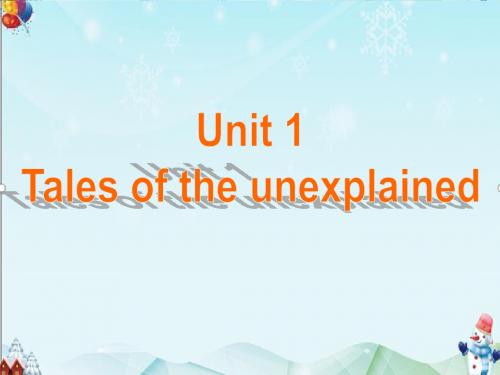
Santiago, 5:40 p.m. May 10, 2004
An unusual creature crossed the road behind one of the police on horseback, meanwhile, strange lights appeared in the same area.
I can’t explain. They are mysterious.
1. What do you know about UFOs or Yetis? Have you ever heaቤተ መጻሕፍቲ ባይዱd anything about that?
2. How do you feel about them? Are you a bit curious?
The most beautiful thing one can experience is mysteries. They are truly the basis of all arts and sciences.
— by Albert Einstein
Look at the following pictures and think about the questions.
You might run into a Yeti in the Himalayas, or just see a few tracks, if you are lucky!
Yetis
1. Where are the Himalayas? 2. What’s the weather like there? 3. Why do some people make great efforts
UFO stands for Unidentified Flying Object. According to some witnesses, it is colorless and moves at a slow, steady speed with little noise.
- 1、下载文档前请自行甄别文档内容的完整性,平台不提供额外的编辑、内容补充、找答案等附加服务。
- 2、"仅部分预览"的文档,不可在线预览部分如存在完整性等问题,可反馈申请退款(可完整预览的文档不适用该条件!)。
- 3、如文档侵犯您的权益,请联系客服反馈,我们会尽快为您处理(人工客服工作时间:9:00-18:30)。
Unit 1 Tales of the unexplained
Part 1: Teaching Design
Aims and requirements
♦ Read a news story about a missing boy and a magazine article about Yeti
♦ Listen to a dialogue between a boss and his employee
♦ Talk about aliens and conduct an interview
♦ Write a report
♦ Tell a mysterious story
Procedures
●Welcome to the Unit
Step 1: Brainstorming
1. Boys and girls, have you ever heard something not only interesting and attractive but
also unexplained at all even with the help of modern science and technology in the world? Here are some pictures on the screen. Can you tell me what they are?
The chances for seeing a UFO are greater for those people who live in small towns or in the country and are outside late at night.
UFOs. Yes, they are called UFOs, meaning unidentified flying objects.
UFOs come in all shapes and sizes. Some are only small spots of light that move in strange patterns across the night sky.
Some can be seen in the daytime are often disk- or saucer-shaped.
UFOs were once seen in different parts of China. Look at some pictures on the screen, please.
Do you think such kind of things mysterious ? Are you curious about them? Besides UFOs, can you list anything more unexplained you’ve ever heard or seen in your daily life?
They are Yetis, the Loch Ness Monster, Stonehenge and the Pyramids in Egypt.
2. Open your books and let’s look at page one. Please read the instruction and focus on the five
pictures and illustrations first. Then answer the following questions:
Do the five pictures have something in common?
If so, what is it? (unexplained; no satisfactory answers; mysterious; no evidence...)
Can scientists explain these phenomena?
How do you feel about them?
Are you a bit curious?
3. Think of as many expressions as possible to answer the questions above. Try to make up some sentences and read them to the class. I will also offer you some examples.
They are mysterious because no satisfactory answers have been offered to explain them. Though these mysteries have puzzled people for a long time, they still show great interest in them. People feel puzzled by the mysteries.
4. Report the information you have collected to the class. Your answers are quite different. Now we will use some of your answers as a prompt for a class discussion. For example,
Teacher:What information have you got about UFOs?
Student A:...
Teacher:Do you think Student A's information interesting? What about the information
you've got? Is there anything different?
Student B:...
5. Please discuss the topics in pairs. Here are some questions.
About UFOs:
Have you ever read some reports about UFOs in China?
Are you interested in UFOs?
Are they really from another planet?
What do the letters UFO stand for?
Why do you think UFOs visit our planet?
About Yetis:
Where are the Himalayas?
What's the weather like there?
Why do some people make great efforts to climb them?
(hobby; dream; challenge themselves; make discoveries; overcome difficulty,..)
A Yeti is reported to be half-man and half-beast. Have you heard of it?
Do you think some climbers' disappearances are connected with Yetis?
About Stonehenge, the pyramids and the Loch Ness Monster:
Stonehenge and the pyramids in Egypt, the most famous of which is the Great Pyramid, are cultural relics.
Where were the pyramids built, on the east coast of the Nile or on the west coast?
What are the reasons?
Do you think the Great Pyramid is a wonder in human history?
How was the Great Pyramid built?
I haven't heard of Stonehenge or the Loch Ness Monster. They are a bit new to me. What about you?。
